EOTP
1/56
There's no tags or description
Looks like no tags are added yet.
Name | Mastery | Learn | Test | Matching | Spaced |
|---|
No study sessions yet.
57 Terms
ecosystem
living + non-living components in an environment and the interrelationships that exist between them
what happens when air meets the stratosphere
it acts as a ceiling and forces the cool air to dissipate
how latitude influences climate
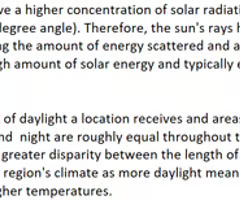
explain the formation of convectional rain at the equator
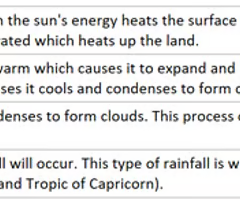
how atmospheric circulation influences the climate and therefore the global distribution of ecosystems
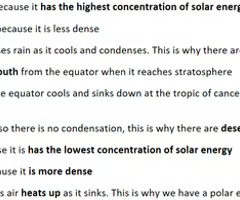
polar climate
long cold winters with short cool summers. Temperatures rarely rise above freezing due to the low angle of the sun's rays. Polar regions tend to be dry precipitation is often less than 250mm per year
polar soils
the ground is permanently frozen below 50cm, this is called permafrost.
There is only a thin humus layer as only a small amount of leaf litter is produced.
Where the ground isn't frozen, the soil is often waterlogged from snow meltwaters or melting permafrost.
polar flora adaptations
Most plants are moss-like for example lichen.Polar regions have very few trees as they have deep root systems and need lots of precipitation to survive.Plants have short roots.Plants such as the arctic pearlwort have small leaves to reduce transpiration (losing water).Plants such as the arctic bearberry are low and compact as polar regions experience very high winds. Only 5% of the polar biome has plant cover.
polar fauna adaptations
adaptations of a polar bear:
large feet spreads load on snow and ice
thick layer of blubber (fat) insulates and stores energy
white fur for camouflage
food web
all the connections between producers and consumers in an ecosystem. The food web shows how interconnected all of the different organisms are.
producers
plants that convert energy from the sun into sugars through photosynthesis
consumers
an organism that obtains its energy by eating other organisms
hot desert climate
High temperatures during the day which plummet during the night owing to the lack of clouds, so the heat escapes easily.
Annual precipitation is around 40mm, and is very unreliable. The 'baked ground' makes infiltration very limited, so water sits on the surface and evaporates during the day.
hot desert flora adaptations
most plants are xerophytic (adapted to little water), eg cacti, whose thick and waxy leaves reduce water loss through transpiration.
bushes grow far apart to avoid competition for water, so vegetation is sparse.
the acacia tree has roots extending 15m down into the ground to tap into groundwater supplies.
when rain does occur plants take full advantage by absorbing large amounts of water.
hot desert fauna adaptations
many animal species are generalists (omnivores) as animal populations are low.
Many animals are nocturnal to avoid the heat during the day.
Small animals bury into the ground such as meerkats which occupy underground tunnel systems. They have also adapted to the venom of scorpions.
Camels have humps on their backs that store fat and water. they have large feet that don't stick into the sand.
temperate grasslands climate
summers are very hot and winters are very cold. average rainfall varies from 250mm to 750mm.
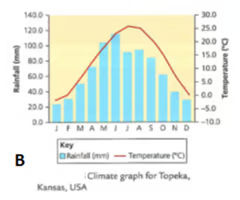
temperate grasslands flora
grasses grow evenly across the land, up to 50cm in height.
trees and shrubs struggle to grow, but some grow along river valleys where more water is available
temperate grasslands fauna
the grasses provide a good habitat for burrowing animals such as rabbits and large herbivores such as bison and antelopes.
carnivores include wolves as well as eagles and hawks.
tropical grasslands climate
temperatures are high throughout the year. There is a longer dry season and a shorter wet season. the wet season occurs when the Sun moves overhead bringing with it the ITCZ. his is a belt of low pressure which brings bursts of heavy rainfall. As the ITCZ moves away the dry season begins.
tropical grasslands flora adaptations
the boabab tree has a thick trunk to store water with thick spongy bark that protects it from bush fires and conserves water. It is also 'shiny' to reflect heat and keep it cool. It has only a small number of leaves to prevent water loss through transpiration. Long roots can tap into ground water supplies.
many trees are xerophytic (drought-resistant) and pyrophytic (fire-resistant)
tropical grasslands fauna adaptations
most animals migrate to find fresh grass for example Saiga Antelopes which have long lanky legs which they have adapted for 'a life on the moon'. They give birth to twins so numbers increase faster. It has a special nose that enables it to smell fresh grass from miles away.
rainforest climate
consistent climate all year round.
very wet with over 2000mm of rainfall per year. very warm with an average daily temperature of 28C.

water cycle in rainforests
high temperatures cause evaporation which rises and cools and condenses to make clouds. This is called convectional rainfall.
water is lost through pores in leaves by evapotranspiration.
Roots take up water through transpiration.
nutrient cycles within rainforests
the forest floor is hot and damp which enables dead plant leaves to decompose quickly.
As organic material such as leaves decay it is recycled so quickly by the nutrient-hungry plants and trees that few nutrients ever reach the soil. heavy rainfall causes nutrients to be leached out of the soil.
rainforest interdependency
strangler figs start out as tiny seeds which are deposited on branches by mammals and birds. Because of the temperature humidity and rainfall the seeds germinate. They grow around trees stealing water and nutrients. The hollow trunk of the strangler fig provides a habitat to thousands of species of invertebrates rodents bats reptiles amphibians and birds. Many other species such as the bonobo are attracted to the strangler fig tree because of its fruits.
rainforests value to humans and the environment - biodiversity
humans:
tourism money helps local economies indigenous tribes use animals as source of food
planet:
keeping biodiversity healthy is important for evolution. species are interdependent so protecting once species protects others in the ecosystem
rainforests value to humans and the environment - carbon storing
carbon being released into the atmosphere would induce global warming
human:
it would cause more extreme weather and natural disaster economic and social impacts
planet:
threatens species and their habitats
rainforests value to humans and the environment - climate regulation
deforestation alters albedo altering temperatures and making them cooler. Rainforests create 50% of their own precipitation through transpiration. Rainforests absorb CO2 and release O2.
humans:
damage to agricultural income as there would be up to 50% less rainfall.
planet:
could have global impacts on climate and therefore all species.
rainforests value to humans and the environment - medicine
humans:
1400 tropical plants with the potential to fight cancer. biochemicals are extracted and are used to synthesise drugs. benefits the entire population of Earth if cures to diseases and cancers were found from the plants in the forest.
planet:
could be used on animals
rainforests value to humans and the environment - people
humans: humans have lived in the Congo for over 50,000 years and at the moment it is home to around 75 million people. it provides food and shelter for indigenous tribes. It is safer than urban areas in a country that has always struggled with law enforcement.
4 threats to biodiversity in the Congo rainforest
logging, mining, agriculture and bush meat trade/poaching
threats to biodiversity in the Congo rainforest - logging
logging occurs when trees are cut down and used for timber.
Across the region forest production as a whole is significantly lower than other regions of the world but has high levels of illegal activity with at least 87% of logging in the DRC being illegal.
The DRC government have allocated 15 million Ha which are legally allowed to be logged.
threats to biodiversity in the Congo rainforest - mining
Mines look for golf diamonds cobalt copper oil and coltan. To access minerals underground trees plants and soil are removed from the tropical rainforest. These resources are often located in the forested areas of the Congo Basin which encourages settlement and deforestation.
Across the DRC at least 2 million people are actively involved in mining and are responsible for producing 90% of the minerals that are exported from the country.
The majority of the world' coltan and other valuable minerals come from Eastern Congo, accounting for 80% of the worlds minerals.
threats to biodiversity in the Congo rainforest - agriculture
For land to be available to grow crops or raise livestock on the tropical rainforest needs to be cut down. More than 20% of deforestation area is used for crops for farming.
2.6 million hectares of land across central and western Africa that are either designated or are under current palm oil cultivation. palm oil plantations have a fraction of the biodiversity of a mature rainforest as well as 1/4 to 1/3 of the carbon.
threats to biodiversity in the Congo rainforest - bush meat trade/poaching
poaching for ivory has meant that African forest elephants occupy only 25% of their previous range as a result of poaching.
More than 32000 animal species are threatened with extinction. Many of these are due to over poaching.
400 - 600 gorillas are killed to poaching every year.
Congo rainforest 3 management strategies
- Virunga National Park
- Forest Stewardship Council Certification
- World bank funding: The Improved Forested Landscape Management Project
Congo Rainforest: Virunga National Park - Positives
ranger force and improve surveillance stops illegal logging and poaching
increase in tourist activities will provide income for locals
60,000 new jobs by 2025
improved drinking water, health and education for 4 million people by 2025
Congo Rainforest: Virunga National Park - Negatives
- 160 rangers in 20 years have been killed on the job
- run by UK charity = lack of local empowerment slow to respond
- in 1994 the Rwandan genocide unleashed a flood of more than one million refugees who placed tremendous pressure on the park forests and wildlife
Congo Rainforest: Forest Stewardship Council Certification - Positives
- the FSC are independent and so are free from corruption from government
- FSC criteria includes whether the rights of local and indigenous peoples are respected and whether there are safe working conditions
- 5 million hectares of rainforest have been FSC certified
Congo Rainforest: Forest Stewardship Council Certification - Negatives
- independent audits of the GFTN saw them mismanage lots of the donated money
Congo Rainforest: WBF, The Improved Forested Landscape Management Project - Positives
- US$40 million in funding
- 100,000 ha of land will be protected
- reduced deforestation due to kerosene stoves and alternative farming methods = 4.5 million tonnes reduction in CO2 equivalent
Congo Rainforest: WBF The Improved Forested Landscape Management Project - Negatives
- money is channelled through the government which is corrupt
- focus on Kinshasa when 60% of the DRC lives in rural areas
- kerosene still produces harmful emissions
location of 6 named reefs
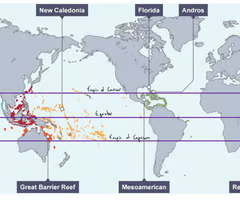
Coral Reef Introduction
Coral reefs are one of the most important ecosystems in the world and have been called the 'rainforests of the sea' owing to the diverse range of plants and animals that they support. Although they cover less than 0.1% of the world's ocean surface they provide a home for at least 25% of all marine species.
What are coral reefs made of?
A coral reef is made of thin layers of calcium carbonate. Coral polyps form a living mat over the calcium carbonate skeleton.
Interdependency in Coral Reefs - Coral and Zooxanthellae
zooxanthellae live within the tissues of the coral polyp. They photosynthesise and produce nutrients for the coral. In exchange the zooxanthellae have access to the waste nutrients produced by the coral (nitrogen and phosphorus)
Interdependency in Coral Reefs - Clownfish and Anemones
Sea anemones are attached to the surface of the coral reef and trap their prey with stinging cells. The clownfish are immune so they make the sea anemones their home to be safe from predators. This also benefits the sea anemone as the clownfishes bright colours attract predators for the sea anemone to catch and digest.
Interdependency in Coral Reefs - Abiotic and Biotic factors
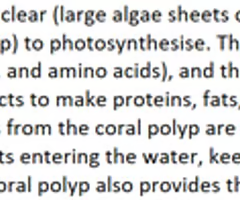
Nutrient Cycling in coral reefs
Zooxanthellae (algae) live within the plant tissues of the coral polyp.
The photosynthesise and provide energy for the coral.
In exchange the zooxanthellae benefit from having exclusive access to waste nutrients produced from the coral which fertilise the algae.
This gives the algae somewhere to live.
Value of the GBR to Humans
embedded in the culture and traditions of the Aboriginal
used in medicines for cancer heart disease and ulcers
supports 70000 jobs
tourism generates AU$6 billion per year 2 million visitors a year
Value of the GBR to the Planet
- more than 1500 species of fish, 10% of global total
- stores more than 1.8 billion tonnes of carbon
- UNESCO world heritage site
- coral reefs form natural barriers that protect the Queensland shoreline form coastal erosion, thereby protecting houses, agricultural land and beaches
4 Threats to the GBR
Climate change
Storm run-off from urbanised catchment areas
Crown of Thorns Starfish
Over-tourism
Threats to the GBR: Climate change
A temperature rise of 2 - 3 C is believed to put 97% of the BGR in danger of bleaching.
When the water temperature rises, the coral polyps get stressed and expel the colourful algae that live inside them, leading to a 'bleaching' effect.
Since the algae provides the coral with over 90% of its energy, the coral starves and dies. This has a ripple effect up the food chain.
Threats to the GBR: Storm run-off
litter washed into the ocean can be ingested by wildlife or cause entanglement
sediment run-off can smother the coral and block light from allowing zooxanthellae to photosynthesise. Nitrogen in fertilisers can cause harmful algal blooms which are a source of food for COTS.
Threats to the GBR: Crown of Thorns Starfish (COTS)
COTS feed on the polyps of coral.
They have been blamed for half of all coral decline over the past 30 years.
Threats to the GBR: Over-tourism
2 million international visitors per year.
Vessels used to transport tourists to the reef cause pollution.
When diving tourists trample over and damage the coral.
Run-off from the tourists' sunscreen contains toxic chemicals which can be absorbed by the corals and kill them.
Threats to the GBR: Storm run-off - MANAGEMENT STRATEGY
CHANGING FARMING PRACTICES
including sediment traps and planting deep-rooted plants such as soya beans to prevent sediment form moving during storms.